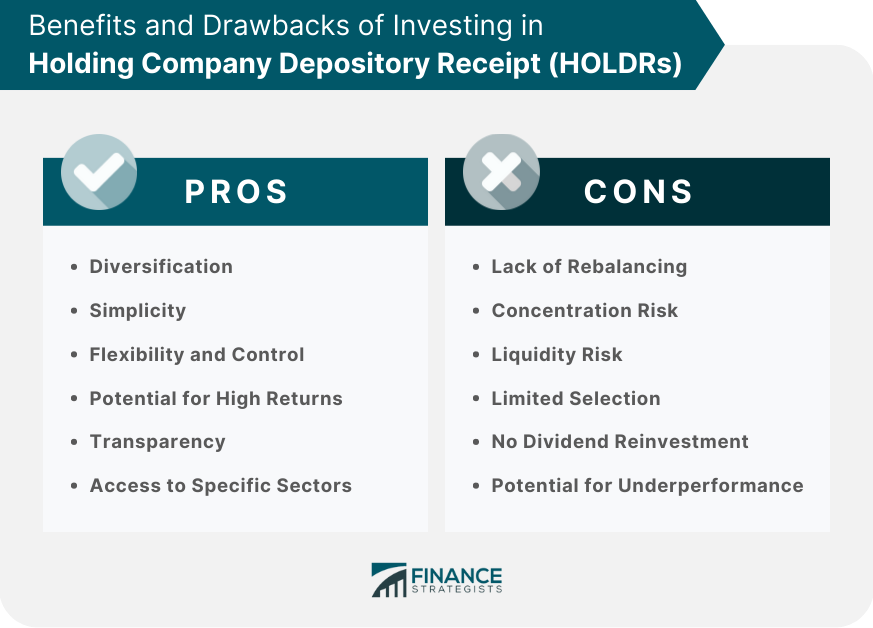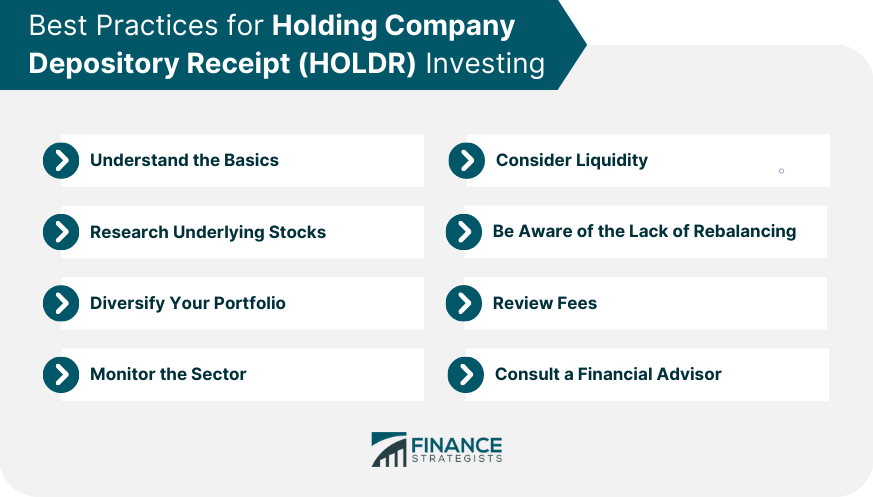Holding Company Depository Receipts are unique securities issued by a trust bank or similar financial institution. They give the holder beneficial ownership in a specified group of stocks. These financial instruments are created when depositary receipts are bundled together to form a single depository receipt that can be traded. HOLDRs offer investors an accessible means to invest in a diversified basket of companies within a particular sector or industry, thus reducing the risk associated with investing in a single company. Essentially, HOLDRs serve as a bridge between individual stocks and exchange-traded funds (ETFs), providing a blend of characteristics of both. HOLDRs were first introduced in the late 1990s by Merrill Lynch. The goal was to provide investors with a simple way to gain exposure to a group of industry-specific stocks without having to buy each stock individually. HOLDRs are created when a group of related stocks is bundled together by a trust. For example, a trust may decide to create a HOLDR for the technology sector, the pharmaceutical sector, or the telecommunications sector. Each HOLDR is a fixed, non-managed collection of stocks that represent a specific sector. Like common stocks, HOLDRs are traded on major stock exchanges. Investors can buy and sell HOLDRs during regular trading hours through their brokerage account. The price of a HOLDR fluctuates throughout the trading day based on the collective market value of the stocks it contains. Investors who purchase a HOLDR have beneficial ownership of the underlying stocks. This is different from mutual funds or ETFs, where investors own units of the fund, but not the underlying securities. One unique feature of a HOLDR is the "unwrap" feature. This allows investors to take possession of the underlying stocks in the HOLDR, offering more control over their investment. However, unwrapping a HOLDR typically involves certain fees and administrative processes. When the companies included in a HOLDR pay dividends, these are passed directly to the investors holding the HOLDR, less any trust fees. Furthermore, investors in a HOLDR have voting rights proportionate to their ownership interest in the underlying companies. The risks and returns associated with a HOLDR are directly tied to the performance of the underlying stocks. If the sector represented by a HOLDR performs well, the value of the HOLDR will likely increase. Conversely, if the sector performs poorly, the value of the HOLDR may decrease. Unlike ETFs or mutual funds, the composition of a HOLDR does not change over time, except in cases where a company in the HOLDR is acquired, merges with another company, or goes bankrupt. This fixed composition means that the HOLDR may become more concentrated over time if certain stocks perform better than others. One of the most prominent benefits of HOLDRs is diversification. Each HOLDR represents ownership in a collection of stocks within a specific industry or sector. Therefore, instead of having to buy individual stocks to gain exposure to a sector, you can buy a single HOLDR. This can help reduce the risk associated with investing in a single company and potentially improve the risk/reward profile of your portfolio. HOLDRs can simplify the investment process. Instead of having to select and manage multiple individual stocks, you can buy a single HOLDR. This means fewer transactions and potentially lower trading costs. Additionally, because HOLDRs are traded on major exchanges like individual stocks, they can be bought or sold throughout the trading day at market prices. The unwrap feature can provide a level of flexibility and control not typically found with other types of pooled investments. HOLDRs can provide the potential for high returns if the sector they represent performs well. For example, a HOLDR representing the technology sector could experience significant gains during a tech boom. HOLDRs are fully transparent. Investors can see exactly which stocks make up the HOLDR and in what proportions. This transparency allows investors to make informed decisions based on the underlying assets. HOLDRs provide an easy way to gain exposure to specific sectors or industries. This can be particularly beneficial for investors who believe in the growth potential of a certain sector but may not have the expertise to select individual stocks within that sector. Unlike mutual funds or exchange-traded funds (ETFs), which are managed by professionals and rebalanced periodically to maintain a specific asset allocation, HOLDRs are not actively managed. The composition of a HOLDR only changes if a company is acquired or goes bankrupt. As such, a HOLDR might become heavily weighted toward a single or a few companies, resulting in higher concentration risk. While HOLDRs offer diversification among a group of companies within a sector, they don't offer diversification across different sectors. This lack of cross-sector diversification means that if a particular sector performs poorly, your investment in a HOLDR from that sector could suffer a significant decline. Some HOLDRs may not be as frequently traded as individual stocks or ETFs, potentially leading to liquidity issues. This means that when you decide to sell, it might be difficult to find a buyer without having to reduce the selling price significantly. The number of HOLDRs available on the market is relatively small compared to other investment products like mutual funds or ETFs. This can limit your options when looking for a HOLDR that aligns with your investment objectives. HOLDRs do not offer a dividend reinvestment plan (DRIP). This means that dividends paid out by the underlying companies are distributed as cash, rather than being automatically reinvested in additional units of the HOLDR. As with any investment, there's a risk that a HOLDR could underperform relative to the broader market or other investment products. Before investing in HOLDRs, ensure you have a solid understanding of what they are and how they work. This includes understanding that HOLDRs are non-managed, sector-specific investment vehicles, and their composition does not change unless a company in the basket is acquired or goes bankrupt. HOLDRs represent a basket of stocks within a specific sector. Therefore, it's crucial to research these underlying stocks before investing. This involves understanding the financial health, performance, and future prospects of these companies. While investing in a HOLDR provides exposure to a range of companies within a specific sector, it doesn't offer diversification across different sectors. To manage risk effectively, ensure that your portfolio is well-diversified across various sectors and asset classes. Since HOLDRs represent specific sectors, it's important to keep an eye on sector performance and trends. If the sector a HOLDR represents is expected to underperform, it might be wise to consider other investment options. Some HOLDRs may not be as frequently traded as individual stocks or ETFs, potentially leading to liquidity issues. This could make it harder to buy or sell shares without affecting the price. Always check the trading volume before investing. Unlike mutual funds or ETFs, HOLDRs do not rebalance to maintain a specific asset allocation. This could potentially lead to a higher concentration of certain stocks in a HOLDR over time. Investors need to monitor their HOLDRs and may need to rebalance their portfolios manually. While HOLDRs typically have lower fees than actively managed funds, they still have costs, including transaction fees for buying and selling shares. It's essential to understand these fees before investing. For those new to investing or unfamiliar with HOLDRs, consulting with a financial advisor could be beneficial. They can provide advice tailored to your specific financial goals and risk tolerance. Holding Company Depository Receipts present a unique investment opportunity, offering a blend of characteristics found in individual stocks and ETFs. They offer the benefit of diversification within a specific sector or industry, as well as the potential for high returns, should the sector perform well. Furthermore, they provide flexibility and control to investors, owing to the "unwrap" feature and the provision of voting rights and dividends from the underlying companies. However, potential investors should not overlook the drawbacks and risks associated with HOLDRs. These include concentration risk due to the lack of rebalancing and cross-sector diversification, potential liquidity issues, limited selection, and the absence of a dividend reinvestment plan. Like all investment strategies, a thorough understanding of the vehicle, comprehensive research on the underlying stocks, a diversified portfolio, and regular monitoring of the sector performance are essential to success. It's always beneficial to consult with a financial advisor for personalized guidance, ensuring that the investment aligns with individual financial goals and risk tolerance.What Is a Holding Company Depository Receipt (HOLDR)?
How HOLDRs Work
Creation of HOLDRs
Trading HOLDRs
Ownership and Control
Dividends and Voting Rights
Risks and Returns
Changes to the Composition
Benefits of Investing in HOLDRs
Diversification
Simplicity
Flexibility and Control
Potential for High Returns
Transparency
Access to Specific Sectors
Drawbacks of Investing in HOLDRs
Lack of Rebalancing
Concentration Risk
Liquidity Risk
Limited Selection
No Dividend Reinvestment
Potential for Underperformance

Best Practices for HOLDR Investing
Understand the Basics
Research the Underlying Stocks
Diversify Your Portfolio
Monitor the Sector
Consider Liquidity
Be Aware of the Lack of Rebalancing
Review Fees
Consult a Financial Advisor

Final Thoughts
Holding Company Depository Receipt FAQs
A Holding Company Depository Receipt is a financial instrument issued by a trust bank or similar financial institution that gives the holder beneficial ownership in a specified group of stocks. It is a way to invest in a basket of companies within a specific sector or industry.
HOLDRs differ from ETFs and mutual funds in several ways. First, the composition of a HOLDR is fixed and doesn't change over time, unless a company in the HOLDR goes bankrupt or is acquired. Second, HOLDRs are non-managed, meaning there's no professional fund manager making decisions about the HOLDR's composition. Lastly, holders of HOLDRs have beneficial ownership of the underlying stocks, not just units of the fund.
Investing in HOLDRs offers several benefits. They provide diversification within a specific industry or sector and the potential for high returns if the sector performs well. They also simplify the investment process as you can buy a single HOLDR instead of having to select and manage multiple individual stocks. Furthermore, they offer a level of transparency, control, and flexibility not typically found in other pooled investments.
There are several risks and drawbacks to consider when investing in HOLDRs. These include concentration risk due to the lack of rebalancing and cross-sector diversification, potential liquidity issues, limited selection, and the absence of a dividend reinvestment plan. Like all investments, there's also the risk that the HOLDR could underperform relative to the broader market or other investment products.
Before investing in a HOLDR, it's essential to understand the basics of how they work and to research the underlying stocks. Ensure that your portfolio is well-diversified across various sectors and asset classes. Monitor the performance and trends of the sector that the HOLDR represents. Also, consider liquidity and the lack of rebalancing. Understand all costs, including transaction fees for buying and selling shares. Lastly, it can be beneficial to consult with a financial advisor for personalized advice.
True Tamplin is a published author, public speaker, CEO of UpDigital, and founder of Finance Strategists.
True is a Certified Educator in Personal Finance (CEPF®), author of The Handy Financial Ratios Guide, a member of the Society for Advancing Business Editing and Writing, contributes to his financial education site, Finance Strategists, and has spoken to various financial communities such as the CFA Institute, as well as university students like his Alma mater, Biola University, where he received a bachelor of science in business and data analytics.
To learn more about True, visit his personal website or view his author profiles on Amazon, Nasdaq and Forbes.











